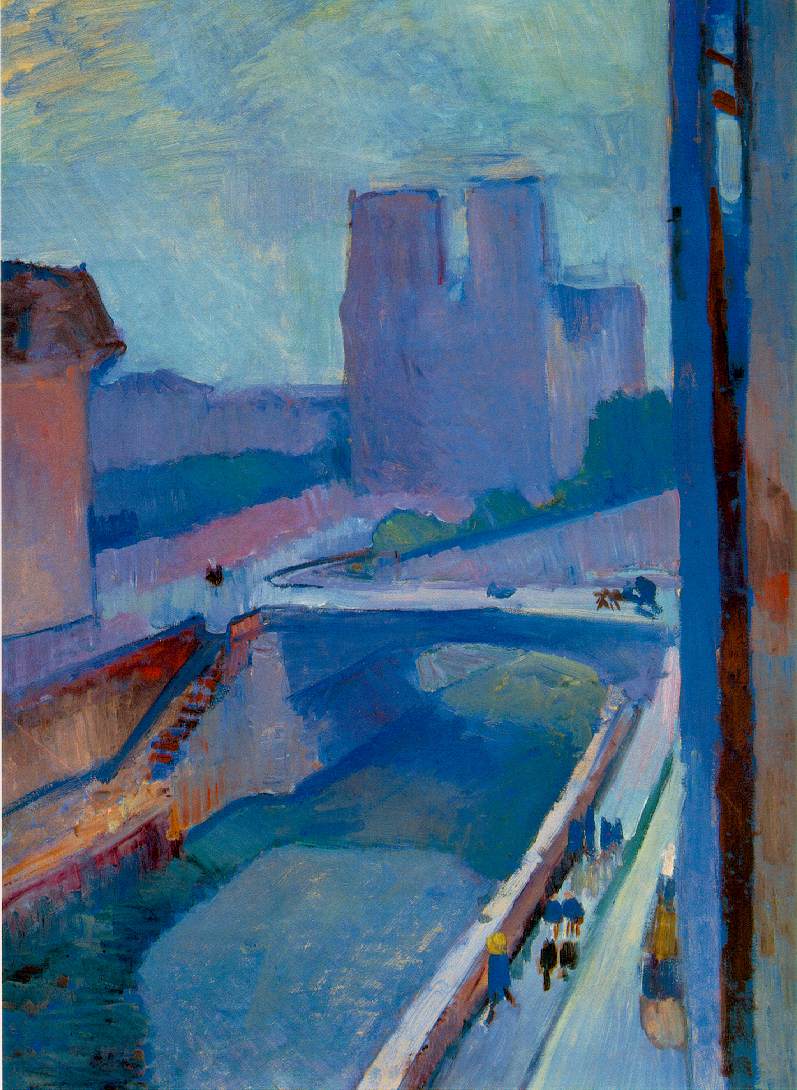
Henri Matisse: A Retrospective

Reproducing more than 400 artworks (320 in color), this hefty catalogue of an exhibition at New York's Museum of Modern Art documents the largest and most ambitious Matisse retrospective ever assembled. In his exciting introductory essay, MoMA curator Elderfield, who organized the exhibit, interprets the artist as a painter of metaphors, signs and analogies that pointed to an internal world of the imagination.
No mere hedonist, Matisse mistrusted visual sensations and aimed at a mode of representation that had the clarity of a text, notes Elderfield, who brilliantly deconstructs the artist's pictorial language. Elderfield shows that the myth of a Golden Age, expressed in images of luxury and erotic fulfillment, is a key influence on a man who decisively altered the way we look at pictures. While the focus here is on painting, numerous drawings, sculptures, prints and stained-glass window designs are also reproduced.

(1869-1954)

Notre-Dame, une fin d'apres-midi 1902
(A Glimpse of Notre Dame in the Late Afternoon)
28 1/2 in x 21 1/2 in
Oil on paper mounted on canvas
Albright-Knox Art Gallery, Buffalo, NY

Studio under the Eaves 1903
"We are in great trouble. The various problems, great and small, more great than small, of which… life has given me a share… practically decided me to give up painting altogether for a quite different job, insipid but sufficiently lucrative to live on…"
Henri Matisse, 15th July 1903.
Something of the despair
expressed by Matisse in this letter to his old friend, Simon Bussy, found its
way on to this canvas, painted at around the same time. It is one of relatively
few works that the artist completed during what has been referred to as his
‘dark period.’ The adjective applies to his mood as much as his palette.
The studio depicted here was on the top floor of 24 Rue Fagard in Bohain, the
small, northern town in which Matisse had grown up and where in 1903 he had
returned, the exhausted and depressed head of a young family.
http://www.fitzmuseum.cam.ac.uk
The Red Studio (Issy-les-Moulineaux) 1911
5 ft 11 1/4 in x 7
ft 2 1/4 in
Oil on canvas
Museum of Modern Art, New York

Porte-Fenetre a Collioure 1914
3 ft 10 in x 2 ft 11 1/2 in
Oil on canvas
Private Collection

Bathers by a River 1909, 1913, and 1916
259.7 x 389.9 cm
Oil on canvas
Charles H. and Mary F. S. Worcester Collection 1953.158
Still dissatisfied with the painting in 1916, Matisse turned the blue stream into a black band, to which he added a white snake (possibly a reference to the snake that tempted Eve in paradise). He isolated the colmnar figures against vertical zones of green, black, white, and grayish blue.
Silhouetted against the light and dark zones at right, these somber figures are far removed from the graceful inhabitants of the original composition. In fact, the panel’s grave tone may reflect Matisse’s reaction to World War I (1914-1918) and the threat it posed to the values of art and life that the artist had originally set out to celebrate.
columnar (adj)
shaped like a
column or other rigid, upright support

Odalisque with Red Culottes 1921

Venus on a Shell I 1930
Bronze. H. 30.5
cm
gift of Lidia Delectorskaya 1971
http://www.hermitagemuseum.org


http://www.musee-matisse-nice.org

The Horse, the Rider, and the Clown 1947
25 5/8 x 16 9/16 in. (65 x 42 cm)
Plate V from the Jazz series
Color pochoir
Gift of Bruce Allyn Eissner, Class of 1965, and Judith Pick Eissner. 80.63.5
Herbert F. Johnson Museum of Art, Cornell University
An early form of stencil print, pochoir was an ideal choice for reproducing Matisse's twenty cut-outs called Jazz, depicting circus scenes, folklore subjects, life in Parisian music halls, and the artist's own travel experiences.
It was in the early 1940s, when he was confined to his bed for most of
the day, that Matisse began to pursue the cut-out as an art form. His assistants
painted opaque watercolor onto white sheets of paper, which Matisse in turn cut
into a variety of shapes, often retaining both the primary form (the "positive")
and the cut-away piece (the "negative"), arranging them in vibrant
juxtapositions. He pinned and re-pinned the pieces to the wall of his studio
until he was finally satisfied with the overall harmony of the composition.
The two principal themes to be found in Jazz are the noise and
excitement of the circus (the series was originally named Le Cirque, but
Matisse changed it before publication) and the syncopated rhythms of popular
jazz music. In the The Horse, the Rider, and the Clown the horse is the
only distinct figure; the equestrienne is implied by her fan-shaped skirt,
overlapping the horse's flank, and the clown by his vibrant costume in green,
black, and yellow.
http://www.museum.cornell.edu/HFJ/handbook/hb155.html

Blue Nude (IV) Nu bleu (IV) 1952
The Swimming Pool 1952-53
7 ft 6 5/8 in x 53 ft 11 in
Esoteric medium
Nine-panel mural in two parts, gouache on cut-and-pasted paper
mounted on burlap
Museum of Modern Art, New York

Les coquelicots; Pomeganate Blossoms 1969
The Wild Poppies
33 3/8 x 137 7/8 in
Stained and leaded glass
five panes, in frame
Formerly Private Collection Pierre Matisse Gallery, New York
The Detroit Institute of Arts
'Blue > e—art—museum' 카테고리의 다른 글
| 한국미술100 년 1부 (0) | 2005.08.12 |
|---|---|
| What is Art? (0) | 2005.07.30 |
| Monterey Museum of Art (0) | 2005.06.20 |
| '황금보다 귀한 보물, 사발' (0) | 2005.03.27 |
| “Through Masters’ Eyes” (0) | 2004.05.26 |




